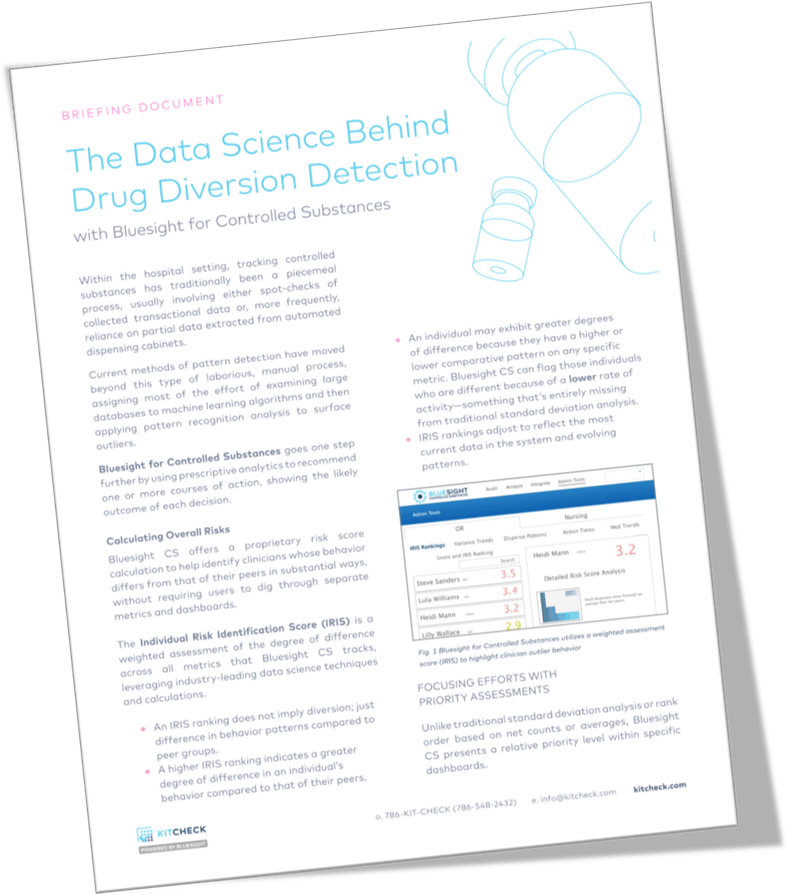However, new machine learning algorithms from Kit Check can quickly analyze large volumes of data from automated dispensing cabinets (ADC) and electronic medical records (EMR) and reveal subtle behavioral differences among hospital staff to detect and highlight where drug diversion risk is present.
We know that drug diversion can occur at any point along the controlled substance distribution chain, from purchase to patient. While closing gaps in the controlled substance record (a fundamental component of remaining compliant with the Controlled Substance Act) is a hospital-wide concern, pharmacy is ultimately responsible for a complete paper trail of all controlled substances at their facility. We also know that the point of dispensing and distribution are the areas that are hardest to track and the most complex to analyze.

Automating Diversion Detection
Many hospitals have tackled this challenge through a variety of processes, physical control mechanisms, and technology investments. Even with these in place, looking for outlier patterns is often a piecemeal process involving either spot-checks of collected transactional data or reliance on partial data extracted from ADCs.
Of course, most hospitals don’t have a full-time data scientist on staff to do the actual analysis.
Data science has two elements that are particularly helpful to hospitals. First, it has the capabilities of separating signal from noise in large data sets. Diversion patterns are often only visible when comparing many variables simultaneously and evaluating those against other patterns.
Second, data science-based analyses can be automated. A data scientist is needed to build the algorithms that surface anomalous behavior, but once that work is done, the software does the work and reports the results.
That is precisely what we have done with Bluesight for Controlled Substances. Data scientists and clinical pharmacists collaborated in evaluating large data sets from our hospital customers. The result is machine learning algorithms that go beyond controlled substance record discrepancies to reveal patterns of behavior that enable us to rank diversion risk by individual.
Specific, Prescriptive Analytics Show You Where to Begin
Bluesight for Controlled Substances goes further than simple pattern recognition by using prescriptive analytics to highlight unusual behaviors. Unlike traditional standard deviation analysis or rank order based on net counts or averages, Bluesight CS presents a relative priority level of these behavior patterns so you can focus on your biggest areas of risk.
To understand unexpected or nonstandard movement and activity patterns, Bluesight for Controlled Substances aggregates data across fifteen separate vectors in a local outlier factor algorithm. This takes into account the totality of a clinician’s behavior in context, which can be crucial to understanding what is (or is not) a serious problem.
Bluesight for Controlled Substances dashboards and analytics tools enable the user to:
-
- Interact with analytics in real time to find a pattern—no more waiting until the end of the month, when it may be too late.
- Drill down into specific data points, like waste witness relationships, location, and time elapsed between transaction events.
- See where drug diversion activity happens, not just what or when.
- Understand differences within peer groups based on the specific group’s patterns.
- Note relationships between individuals exhibiting anomalous behavior.
To learn more about how Bluesight leverages data science and real-time analytics to detect diversion of controlled substances, download our briefing document by clicking the button below.
[button href=”https://bluesight.com/learn-more/documentation/the-data-science-behind-drug-diversion-detection” class=”mvm”][x_icon type=”cloud-download”]Download Brief[/button]